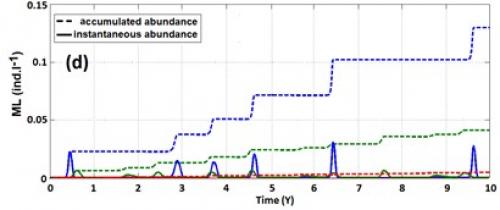E Alekseenko (OT-Med post-doc)
M Baklouti & F Carlotti (MIO)
P Garreau & B Thouvenin (Ifremer)
This project aims at understanding how large spatial and temporal nutrient gradients shape the planktonic communities of the Mediterranean sea. The ratios of N to P in seawater and in the metabolic requirements for plankton growth are of particular interest as they determine which nutrient limit biological productivity at the base of the food web and thereby select plankton communities with distinct biogeochemical function.
The cascading impact of the nutrient quantitative and qualitative inputs through the planktonic trophic chain remains poorly understood. In this project a coupled model (Mars3D-Eco3M) for the NW Mediterranean is used. It offers new potential because it uses a hydrodynamical model that has been repeatedly validated with an adequate spatial resolution (1.2 x 1.2 km mesh) to incorporate the mesoscale dynamics; it is also coupled with a biogeochemical model implemented in the Eco3M platform (variable stoichiometry).
A coupled 3D physical-biogeochemical model (MARS3D-MENOR/Eco3M-MED) has been developed and applied to the NW Mediterranean Sea, yielding the following results:
- Temporal and spatial variability of the stoichiometry of living and non-living compartments were investigated.
- the Rhone River inputs were shown to have a significant impact on the N/P ratio in the Gulf of Lion.
- the NO3 /PO4 ratio and its deviation from the Redfield ratio cannot be used as the sole indicator of nutrient limitation since no correlation could be found between this ratio and the intracellular N/P of large phytoplankton
A population model of the marine invasive ctenophore species Mneniopsis leidyi (ML) including physiological and demographic processes was also included in the Eco3M-MED model to define possible environmental windows favourable to ML adaptation and pullulations in invaded habitats, such as the coastal areas of the Mediterranean Sea, yielding the following results :
- the required food conditions for ML outbursts should mainly be found in the most productive Mediterranean coastal areas.
- variations in food concentrations may induce rapid outbursts or collapse of ML populations.
- for a given fixed available prey biomass, ML abundance is maximum for the prey of richest nutritional value.
- the disappearance of ML over several years, also observed in nature, was reproduced and the model suggests that this results from a combination of species properties and environmental forcing.
The strongest forcing influence on ML dynamics is the reduction of fish competitors for food due to an increase in fishing pressure, showing a significant impact not only on the outbreaks frequency, but also on ML cumulated population growth over a ten-year period.
This project was a stepping stone for the OCEAN part of the LASERMED project .
ML instantaneous and cumulated abundance for an increasing fishing pressure on small pelagic fishes (implicitly represented in the model).
Red : reference scenario;
Green: the fishing pressure is twice that of the reference;
Blue: the fishing pressure is three times that of the reference;



